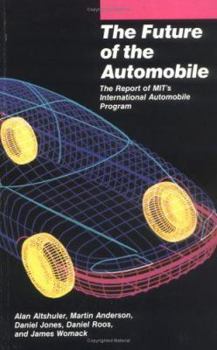The Future of the Automobile: The Report of Mit's International Automobile Program
A new shape for the world auto industry emerges from this far-ranging study, which reveals a path of development quite different from those widely forecast and leaves no doubt that the changes ahead will be dramatic.Cited by Business Week as one of 1984's ten best books on business and economics, The Future of the Automobile is the most comprehensive assessment ever conducted of the world's largest industry. It is a collaborative study by leading researchers and industry experts in Japan, Germany, France, Italy, Sweden, the United Kingdom, and the United States that covers the industry at the firm level and at the global level. It projects the composition of the industry 20 years hence, estimates long-term demand for the product, focuses on the growing cooperation between producers on individual models even as overall competition in the industry intensifies, and reveals alternative paths for industrial relations.Alan Altshuler is Dean of the Graduate School of Public Administration at New York University. Daniel Roos is Director of the Center for Transportation Studies and Professor of Civil Engineering at MIT where Martin Anderson and James Womack also teach. Daniel Jones teaches at the University of Sussex.
Format:Paperback
Language:English
ISBN:0262510383
ISBN13:9780262510387
Release Date:October 1986
Publisher:MIT Press
Length:334 Pages
Weight:1.17 lbs.
Dimensions:0.8" x 6.0" x 9.2"
Age Range:18 years and up
Grade Range:Postsecondary and higher
Customer Reviews
1 rating
Thoroughly informative
Published by Thriftbooks.com User , 25 years ago
When the average person thinks of the automobile industry, thefollowing names like Ford, General Motors, Chrysler, Honda, Toyota,Saab, etc. are likely to leap to mind. But what MIT's report points out is that the modern automobile industry is not represented just by these finished-product assemblers, but by suppliers and component craftsmen that constitute an extremely complex web that make up "the automobile industry." But the complexity of the automobile industry rests not only on the composition of the industry itself, but also the international environment within which the industry must operate. Domestic auto industries hold a special position in most countries in that most governments see the very existence of domestic auto producers as a good unto itself. For example, if a Japanese producer can engineer and produce a better widget, chances are that that producer will be able to market that product domestically and internationally with great success if widgets are not seen as a major threat to an important industry of another nation. But with automobiles (as was the case for Japanese producers in the early 1970's), the prospects for successful international competition is not so clear-cut. Automobile producers are therefore constrained not only by the forces of the market and competitors, but also by domestic and foreign governments that take a special interest in the success or failure of their firms.






